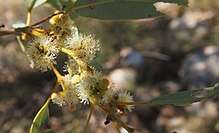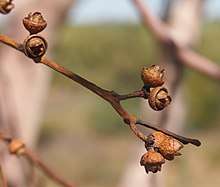Eucalyptus leucophloia
| Snappy gum | |
|---|---|
 | |
| Scientific classification | |
| Kingdom: | Plantae |
| Clade: | Angiosperms |
| Clade: | Eudicots |
| Clade: | Rosids |
| Order: | Myrtales |
| Family: | Myrtaceae |
| Genus: | Eucalyptus |
| Species: | E. leucophloia |
| Binomial name | |
| Eucalyptus leucophloia | |



Eucalyptus leucophloia, commonly known as snappy gum or migum, is a mallee that is native to northern Australia.[1] The Indigenous Mangarayi and Yangman peoples know the tree as Mirndir[2] the Ngarluma name it as Malygan and Yindjibarndi peoples know the tree as Majgan.[3]
Description
The mallee or tree typically grows to a height of 2.5 to 10 metres (8 to 33 ft) and has smooth powdery bark. The tree blooms between March and August and produces white-cream flowers.[1] It can have a single stem or multiple stems forming from a lignotuber. The trunk is often crooked and has a base diameter of around 40 cm (16 in).[4] The new bark is pale pink to pale orange which matures to white and ages in patches to dark pink or grey.[2] The crown of the tree is usually as wide as the three is tall and it has a moderately dense canopy.[4] The concolorous, dull, green to grey-green to blue-grey adult leaves usually have an alternate but sometimes sub-opposite arrangement. The leaf blade has a lanceolate to ovate shape and is 5 to 12 cm (2 to 5 in) in length and 1 to 4 cm (0.4 to 1.6 in) wide and is basally tapered.[2]
Each terminal, axillary inflorescence is made up of seven to eleven flowers. The buds are ovoid or double conic with a length of 0.5 to 0.9 cm (0.20 to 0.35 in) and a width of 0.3 to 0.5 cm (0.12 to 0.20 in). The fruits are 0.5 to 0.8 cm (0.20 to 0.31 in) long and 0.4 to 0.6 cm (0.16 to 0.24 in) wide and have a hemispherical or cupular shape. The disc of the fruit is narrow, obscure and depressed and the valves are exserted. Fruits contain yellow-brown seeds with a round or elliptical shape.[4]
Taxonomy
The species was first formally described by the botanist Ian Brooker in 1976 as part of the work Six new taxa of Eucalyptus from Western Australia as published in the journal Nuytsia.[5] The type specimen had been collected by Alexander Segger George in 1971 from around the Rudall River.[6]
The species name leucophloia is taken from the Greek words, leukos meaning white and phloeos meaning bark, in reference to the light coloured bark.[4]
There are two known subspecies:
- Eucalyptus leucophloia Brooker subsp. leucophloia
- Eucalyptus leucophloia subsp. euroa L.A.S.Johnson & K.D.Hill[7]
Brooker placed E.leucophloia in a section made up of six species called platysperma. It is most closely related to Eucalyptus brevifolia and Eucalyptus confluens.[4]
Distribution
It is found in gullies and on hills and plains in the western Pilbara region of Western Australia where it grows in skeletal soils over sandstone.[1] Its range extends into central parts of the Northern Territory between Katherine, Tennant Creek and the southern part of Arnhem Land[2] and into north western Queensland[6] between Mount Isa, Cloncurry and Dajarra.[4] Eucalyptus leucophloia subsp. leucophloia is confined to Western Australia while subsp euroa is found in the Northern Territory and Queensland.[4]
Found among low woodland communities it will often form pure stands over an understorey of Acacia shrubs and Triodia spinifex grasses. In a mixed woodland is often associated with Eucalyptus gamophylla, Corymbia terminalis and Eucalyptus odontocarpa.[4]
See also
References
- 1 2 3 "Eucalyptus leucophloia". FloraBase. Western Australian Government Department of Parks and Wildlife.
- 1 2 3 4 "Eucalyptus leucophloia Brooker". FloraNT. Northern Territory Government. Retrieved 9 December 2017.
- ↑ Todd Erickson, Russell Barrett, David Merritt and Kingsley Dixon (2016). Pilbara Seed Atlas and Field Guide: Plant Restoration in Australia's Arid Northwest. CSIRO publishing. ISBN 9781486305544.
- 1 2 3 4 5 6 7 8 D.J.Boland, M.I.H. Brooker, G.M. Chippendale, N. Hall, B.P.M Hyland, R.D. Johnston, D.A. Kleinig, M.W. McDonald and J.D. Turner (2006). Forest Trees of Australia. CSIRO publishing. ISBN 9780643098947.
- ↑ "Eucalyptus leucophloia Brooker". Atlas of Living Australia. Global Biodiversity Information Facility. Retrieved 10 December 2017.
- 1 2 "Eucalyptus leucophloia". Eucalink. Royal Botanic Garden, Sydney. Retrieved 10 December 2017.
- ↑ "All Names - Eucalyptus". Euclid. CSIRO publishing. Retrieved 10 December 2017.